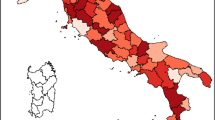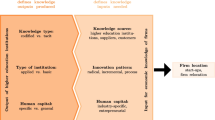Abstract
We use detailed longitudinal data on firms, human capital and universities to study the impact of geographical proximity to knowledge sources and local absorptive capacity on the regional location of knowledge-based start-ups. Using municipalities as the regional unit of analysis, we examine the influence of the regional distribution of universities, yearly numbers of students and graduates, and workforce education on new start-up numbers. We estimate models of regional entry using zero inflated negative binomial regression. We find that local access to knowledge and human capital significantly influences entry by knowledge-based firms into regions, after controlling for other regional-level variables.
Similar content being viewed by others
References
Acosta M, Coronado D (2004) The effects of scientific regional opportunities in science-technology flows: evidence from scientific literature in firms. ERSA conference papers
Acs Z, Plummer LA (2005) Penetrating the ‘Knowledge Filter’ in regional economies. Ann Reg Sci 39: 439–456
Acs Z, Audretsch DB, Feldman M (1994) R&D spillovers and recipient firm size. Rev Econ Stat 76: 336–340
Andersson R, Quigley JM, Wilhelmsson M (2005) Agglomeration and the spatial distribution of creativity. Pap Reg Sci 84: 445–464
Anselin L, Varga A, Acs Z (1997) Local geographic spillovers between university research and high technology innovations. J Urban Econ 42: 422–448
Anselin L, Varga A, Acs Z (2000) Geographic and sectoral characteristics of academic knowledge externalities. Pap Reg Sci 79: 435–443
Armington C, Acs Z (2002) The determinants of regional variation in new firm formation. Reg Stud 36: 33–45
Audretsch DB (1998) Agglomeration and the location of innovative activity. Oxford Rev Econ Policy 14: 19–28
Audretsch DB (2003) Innovation and spatial externalities. Int Reg Sci Rev 26: 167–174
Audretsch DB, Feldman MP (2004) Knowledge spillovers and the geography of innovation. In: Henderson V, Thisse JF(eds) Handbook of regional and urban economics vol 4.. Elsevier, Amsterdam, pp 2713–2739
Audretsch DB, Fritsch M (1994) The geography of firm births in Germany. Reg Stud 28: 359–365
Audretsch DB, Stephan PE (1996) Company-scientist locational links: the case of biotechnology. Am Econ Rev 86: 641–652
Audretsch DB, Lehmann E, Warning S (2004) University spillovers: does the kind of science matter. Ind Innov 11: 193–205
Audretsch DB, Lehmann E, Warning S (2005) University spillovers and new firm location. Res Policy 34: 1113–1122
Bade FJ, Nerlinger EA (2000) The spatial distribution of new technology based firms: empirical results for West-Germany. Pap Reg Sci 79: 155–176
Bania N, Eberts RW, Fogarty MS (1993) Universities and the start-up of new companies: can we generalize from route 128 and silicon valley. Rev Econ Stat 75: 761–766
Baptista R (1998) Industrial clusters and the geography of innovation and production: a survey of the literature. In: Swann P, Prevezer M, Stout D(eds) The dynamics of industrial clustering. Oxford University Press, London, pp 13–51
Baptista R, Preto MT (2006) Entrepreneurship and industrial re-structuring: what kinds of start-ups matter most for job creation? Discussion Paper # 06/06, Centre for Innovation, Technology and Policy Research, IN+, Instituto Superior Técnico, Technical University of Lisbon
Baptista R, Swann P (1998) Do firms in clusters innovate more?. Res Policy 27: 525–540
Baptista R, Swann P (1999) A comparison of clustering dynamics in the US and UK computer industries. J Evol Econ 9: 373–399
Bartik TJ (1985) Business location decisions in the United States: estimates of the effects of unionization, Taxes, and other characteristics of states. J Bus Econ Stat 3: 14–22
Baum JAC, Sorenson O (2003) Advances in strategic management: geography and strategy, vol 20. JAI Press, Greenwich
Boschma RA, Lambooy JG (1999) Evolutionary economics and economic geography. J Evol Econ 9: 411–429
Bóia MJ (2003) Determinants of innovation in Portugal designing, implementing and analyzing evidence from the third community innovation survey. Master Dissertation, Instituto Superior Técnico, Technical University of Lisbon
Cabral LMB, Mata J (2003) On the evolution of the firm size distribution: facts and theory. Am Econ Rev 93: 1075–1090
Cameron C, Trivedi P (1986) Econometric models based on count data: comparisons of some estimators and tests. J Appl Econom 1: 29–54
Cameron C, Trivedi P (1990) Regression based tests for overdispersion in the Poisson model. J Econom 46: 347–364
Capello R (2002) Entrepreneuship and spatial externalities: theory and measurement. Ann Reg Sci 36: 387–402
Carlton DW (1983) The location and employment choices of new firms: an econometric model with discrete and continuous endogenous variables. Rev Econ Stat 54: 440–449
Cassia L, Colombelli A (2008) Do universities knowledge spillovers impact on new firm’s growth? Empirical evidence from UK. Int Entrepreneurship Manag J. doi:10.1007/s11365-008-0084-1
Cesário M, Vaz MTN (2004) Territory and entrepreneurial performance: an exercise on some industrial Portuguese regions. ERSA conference papers
Cohen WM, Levinthal DA (1989) Innovation and learning: the two faces of R&D. Econ J 99: 569–596
Cohen WM, Levinthal DA (1994) Fortune favors the prepared firm. Manag Sci 40: 227–251
Costa J, Teixeira AC (2005) Do universities influence innovative efforts and location choices of technology based firms? The case of Portugal. DRUID Academy
Faberman RJ (2005) What’s in a city? Understanding the micro-level employer dynamics underlying urban growth. BLS WORKING PAPERS, Working Paper 386
Feldman MP (2000) Location and innovation: the new economic geography of innovation. In: Clark G, Feldman MP, Gertler M(eds) Oxford handbook of economic geography. Oxford University Press, Oxford
Feldman MP, Audretsch DB (1999) Innovation in cities: science-based diversity, specialization and localized competition. Eur Econ Rev 43: 409–429
Figueiredo O, Guimarães P, Woodward D (2002) Home-field advantage: location decisions of Portuguese entrepreneurs. J Urban Econ 52: 341–361
Fisher MM, Varga A (2003) Spatial knowledge spillovers and university research: evidence from Austria. Ann Reg Sci 37: 303–322
Florida R (1995) Towards the learning region. Futures 27: 527–536
Fritsch M, Falk O (2007) New firm formation by industry over space and time: a multi-level analysis. Reg Stud 41: 157–172
Fritsch M, Mueller P (2004) The effects of new business formation on regional development over time. Reg Stud 38: 961–975
Fujita M, Thisse JF (1996) Economics of agglomeration. J Jpn Int Econ 10: 339–378
Gertler MS (1995) “Being There”: proximity, organization, and culture in the development and adoption of advanced manufacturing technologies. Econ Geogr 71: 1–26
Glaeser EL, Kallal HD, Scheinkman JA et al (1992) Growth in cities. J Political Econ 100: 1126–1152
Giarratana MS (2004) The birth of a new industry: entry by start-ups and the drivers of firm growth. The case of encryption software. Res Policy 33: 787–806
Gilbert BA, Kusar MT (2006) The influence of geographic clusters and knowledge spillovers on the product innovation activities of new ventures. Max Planck Institute of Economics Discussion Paper on entrepreneurship, Growth and Public Policy #16/06
Greene WH (1994) Accounting for excess zeros and sample selection in poisson and negative binomial regression models. Mimeo, NYU Stern School of Business
Griliches Z (1992) The search for R&D spillovers. Scand J Econ 94(Suppl):29–47
Hall BH, Link AN, Scott JT (2003) Universities as research partners. Rev Econ Stat 85: 485–491
Henderson JV (1974) The sizes and types of cities. Am Econ Rev 64: 640–656
Holl A (2004) Transport infrastructure, agglomeration economies, and firm birth: empirical evidence from Portugal. J Reg Sci 44: 693–712
Iammarino S, McCann P (2006) The structure and evolution of industrial clusters: transactions, technology and knowledge spillovers. Res Policy 35: 1018–1036
Jacobs J (1969) The economy of cities. Penguin Books, London
Kangasharju A (2000) Regional variations in firm formation: panel and cross-section data evidence from Finland. Pap Reg Sci 79: 355–373
Karlsson C, Nyström K (2006) Knowledge accessibility and new firm formation. CESIS Working Paper
Keeble D, Wilkinson F (1999) Collective learning and knowledge development in the evolution of regional cluster of high technology SMEs in Europe. Reg Stud 33: 295–303
Krugman P (1991) Increasing returns and economic geography. J Political Econ 99: 483–499
Markusen A, Hall P, Glasmeier A (1986) High tech America: the what, how, where, and why of the sunrise industries. Allen & Unwin, Boston
Michelacci C, Silva O (2005) Why so many local entrepreneurs? CEMFI Working Paper No. 0506
Moyano P, Fariña B, Aleixandre G, Ogando O (2005) Enterprise creation at a local scale: determining factors in the case of municipalities in Castilla y Leon. ERSA conference papers
Mullahy J (1997) Heterogeneity, excess zeros, and the structure of count data models. J Appl Econom 12: 337–350
OECD (2002) Science, technology and industry. Paris
Porter ME (2003) The economic performance of regions. Reg Stud 37: 49–578
Reynolds P, Storey DJ, Westhead P (1994) Cross-national comparisons of the variation in new firm formation rates. Reg Stud 28: 443–456
Scott AJ (1992) Industrial organization and location: division of labour, the firm, and spatial process. Econ Geogr 62: 215–231
Shane S (1996) Explaining variation in rates of entrepreneurship in the United States: 1899–1988. J Manag 22: 747–781
Shane S (2000) Prior knowledge and the discovery of entrepreneurial opportunities. Organ Sci 11: 448–469
Siegfried JJ, Evans LB (1994) Empirical studies of entry and exit: a survey of the evidence. Rev Ind Organ 9: 121–155
Simmie J (2002) Knowledge spillovers and reasons for the concentration of innovative SMEs. Urban Stud 39: 885–902
Simmie J, Lever WF (2002) Introduction: the knowledge based city. Urban Stud 39: 855–857
Sorenson O, Audia G (2000) The social structure of entrepreneurial activity: geographic concentration of footwear production in the U.S., 1940–1989. Am J Sociol 106: 324–362
Stahlecker T, Koschatzky K (2004) On the significance of geographical proximity for the structure and development of newly founded knowledge intensive business service firms. Working Papers Firms and Regions, No. R2/2004, Fraunhofer Institute
Storey DJ (1984) Small firms in regional economic development. Reg Stud 18: 197–275
Stuart TE, Sorenson O (2003) The geography of opportunity: spatial heterogeneity in founding rates and the performance of biotechnology firms. Res Policy 25: 1139–1157
Varga A (2000) Local academic knowledge transfers and the concentration of economic activity. J Reg Sci 40: 289–309
Zucker L, Darby MR, Armstrong J (1998) Intellectual human capital and the birth of U.S. biotechnology enterprises. Am Econ Rev 88: 290–306
Zucker L, Darby MR, Armstrong J (2002) Commercializing knowledge: university science, knowledge capture, and firm performance in biotechnology. Manag Sci 48: 138–153
Author information
Authors and Affiliations
Corresponding author
Rights and permissions
About this article
Cite this article
Baptista, R., Mendonça, J. Proximity to knowledge sources and the location of knowledge-based start-ups. Ann Reg Sci 45, 5–29 (2010). https://doi.org/10.1007/s00168-009-0289-4
Received:
Accepted:
Published:
Issue Date:
DOI: https://doi.org/10.1007/s00168-009-0289-4




